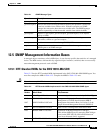
CHAPTER
12-1
Cisco ONS 15310-MA SDH Reference Manual, Release 9.1 and Release 9.2
78-19417-01
12
SNMP
This chapter explains Simple Network Management Protocol (SNMP) as implemented by the
Cisco ONS 15310-MA SDH.
For SNMP set up information, refer to the Cisco ONS 15310-MA SDH Procedure Guide.
Chapter topics include:
• 12.1 SNMP Overview, page 12-1
• 12.2 SNMP Basic Components, page 12-2
• 12.3 SNMP Version Support, page 12-4
• 12.4 SNMP Message Types, page 12-4
• 12.5 SNMP Management Information Bases, page 12-5
• 12.6 SNMP Trap Content, page 12-11
• 12.7 SNMPv1/v2 Community Names, page 12-12
• 12.8 SNMPv1/v2 Proxy Support Over Firewalls, page 12-13
• 12.9 SNMPv3 Proxy Configuration, page 12-13
• 12.10 SNMP Remote Monitoring, page 12-14
12.1 SNMP Overview
SNMP is an application-layer communication protocol that allows network devices to exchange
management information. SNMP enables network administrators to manage network performance, find
and solve network problems, and plan network growth. Up to ten SNMP trap destinations and five
concurrent Cisco Transport Controller (CTC) user sessions are allowed per node.
The ONS 15310-MA SDH use SNMP to provide asynchronous event notification to a network
management system (NMS). ONS SNMP implementation uses standard Internet Engineering Task Force
(IETF) management information bases (MIBs) to convey node-level inventory, fault, and performance
management information for E1, DS3, SDH, and Ethernet read-only management. SNMP allows limited
management of the ONS 15310-MA SDH by a generic SNMP manager—for example, HP OpenView
Network Node Manager (NNM) or Open Systems Interconnection (OSI) NetExpert.
The ONS 15310-MA SDH supports SNMP Version 1 (SNMPv1), SNMP Version 2c (SNMPv2c), and
SNMP Version 3 (SNMPv3). As compared to SNMPv1, SNMPv2c includes additional protocol
operations. SNMPv3 provides authentication, encryption, and message integrity and is more secure. This
chapter describes the SNMP versions and explains how to configure SNMP on the ONS 15310-MA
SDH.


















